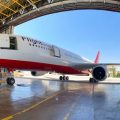
For an airplane to keep flying, several essential components and factors must work together seamlessly to generate lift, maintain stability, and propel the aircraft forward. From the aerodynamic design of the wings to the power generated by the engines and the control provided by the flight controls, each aspect plays a crucial role in ensuring the safety and efficiency of flight operations. This article will explore the key elements that an airplane needs to keep flying, from lift and propulsion to navigation and communication systems.
1. Lift
The aerodynamic design of the wings of an airplane allows it to generate lift, which is essential for continuous flight. Airflow over the wing’s curving surface generates lift, an upward force, due to the pressure differential between the wing’s top and lower surfaces. A plane’s ability to generate lift is dependent on its speed, wing size, shape, and angle. Lift is the key to sustained flight because it mitigates the effects of gravity and keeps the aircraft aloft.
2. Ground Support Equipment
Ground support equipment, including specialized tools and machinery, plays a pivotal role in ensuring the seamless operation of an airplane. These essential pieces of equipment encompass a wide range of functions, from aircraft servicing and maintenance to passenger boarding and baggage handling. Among the notable manufacturers of ground support equipment is Tronair, known for producing high-quality and reliable equipment tailored to the needs of the aviation industry. These products, such as aircraft jacks, towbars, and hydraulic power units, are designed to meet stringent safety standards and enhance efficiency on the ground. With this innovative solution and other ground support equipment, airports and aviation professionals can maintain the safety, reliability, and punctuality of flight operations, keeping airplanes flying smoothly and passengers traveling with confidence.
3. Control Surfaces
To maintain stability and control in flight, airplanes are equipped with control surfaces, including ailerons, elevators, and rudders. Ailerons, located on the trailing edge of the wings, control the aircraft’s roll motion by deflecting upward or downward to bank the airplane left or right. Elevators, typically located on the horizontal stabilizer, control the aircraft’s pitch motion by deflecting upward or downward to raise or lower the nose of the airplane. Rudders, located on the vertical stabilizer, control the aircraft’s yaw motion by deflecting left or right to maintain directional stability. These control surfaces enable pilots to maneuver the aircraft effectively and maintain stable flight conditions.
To ensure safe and efficient navigation from takeoff to landing, contemporary aviation relies heavily on navigation technologies to guide aircraft along their planned flight routes. Several navigational aids, including VHF Omnidirectional Range (VOR) radios, inertial navigation systems (INS), and the Global Positioning System (GPS), are standard onboard aircraft. For accurate navigation and route planning, these technologies provide pilots with real-time data regarding the location, height, direction, and velocity of the aircraft. Radar systems may also help planes avoid bad weather and keep an eye out for other planes in the area, and TCAS (Traffic Collision Avoidance System) can notify pilots when other planes are approaching.
5. Communication Systems
Effective communication is essential for safe and coordinated flight operations, both between pilots and air traffic controllers and among crew members on board the aircraft. Aircraft are equipped with various communication systems, including VHF (Very High Frequency) radios, HF (High Frequency) radios, and satellite communication systems. These systems enable pilots to communicate with air traffic control facilities, receive flight clearances, and obtain weather updates and other important information. Additionally, aircraft can be equipped with intercom systems and cockpit voice recorders to facilitate communication among crew members and ensure effective teamwork during flight operations.
Conclusion
In conclusion, an airplane requires several essential components and systems to keep flying safely and efficiently. From lift and GSE to control surfaces, navigation systems, and communication systems, each element plays a critical role in sustaining flight and ensuring the safety of passengers and crew. By understanding the importance of these components and their functions, pilots and aviation professionals can effectively operate and navigate aircraft in various flight conditions and environments. Ultimately, the successful coordination and integration of these essential elements contribute to the continued success of flight operations and the advancement of aviation technology.






